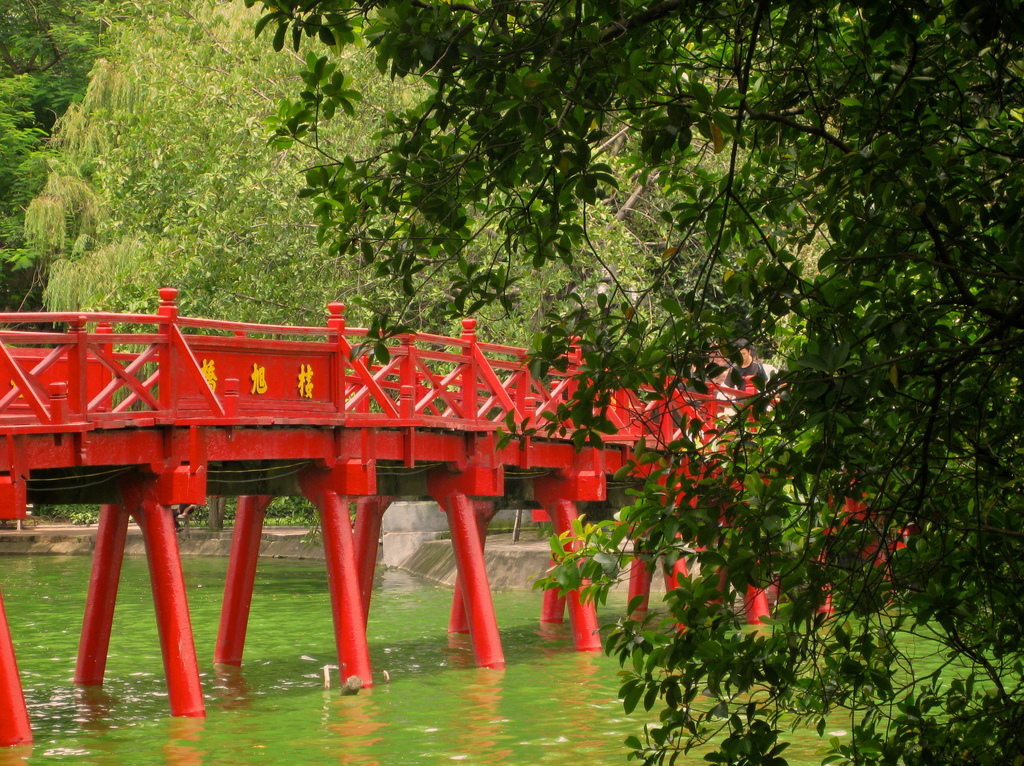Thê Húc Bridge on:
[Wikipedia]
[Google]
[Amazon]
Thê Húc Bridge ( vi, Cầu Thê Húc, chữ Nôm: 橋棲旭), is a
 In 1865, during the reign of
In 1865, during the reign of
 The bridge now consists of 15 spans with 32 round wooden pillars arranged in 16 pairs. The bridge deck is paved and the surface railings are painted dark red, with the words 棲旭橋 (Thê Húc Kiều) gilded. Although still hallowed to a certain extent, it is now widely visited by a broad range of locals and tourists who purchase a ticket.
The bridge now consists of 15 spans with 32 round wooden pillars arranged in 16 pairs. The bridge deck is paved and the surface railings are painted dark red, with the words 棲旭橋 (Thê Húc Kiều) gilded. Although still hallowed to a certain extent, it is now widely visited by a broad range of locals and tourists who purchase a ticket.
File:Thê Húc bridge with flags.jpg, Bridge entering the temple with flags displayed
File:Cầu Thê Húc (Hà Nội).jpg, The bridge
File:Cauthehuc.jpg, The bridge at night in 2015
File:Students in Hanoi having a study break.jpg, Students in 2016 at the lakeside across the bridge
footbridge
A footbridge (also a pedestrian bridge, pedestrian overpass, or pedestrian overcrossing) is a bridge designed solely for pedestrians.''Oxford English Dictionary'' While the primary meaning for a bridge is a structure which links "two points at a ...
over Hoàn Kiếm Lake
Hoàn Kiếm Lake ( vi, Hồ Hoàn Kiếm, chữ Hán: 湖還劍, meaning ''"Lake of the Returned Sword"'' or ''"Lake of the Restored Sword"''), also known as Sword Lake (''Hồ Gươm'') or Tả Vọng Lake (''Hồ Tả Vọng''), is a fresh w ...
within Hanoi
Hanoi or Ha Noi ( or ; vi, Hà Nội ) is the capital and second-largest city of Vietnam. It covers an area of . It consists of 12 urban districts, one district-leveled town and 17 rural districts. Located within the Red River Delta, Hanoi is ...
, Vietnam
Vietnam or Viet Nam ( vi, Việt Nam, ), officially the Socialist Republic of Vietnam,., group="n" is a country in Southeast Asia, at the eastern edge of mainland Southeast Asia, with an area of and population of 96 million, making i ...
.
History
 In 1865, during the reign of
In 1865, during the reign of Tự Đức
Tự Đức (, vi-hantu, 嗣 德, lit. "inheritance of virtues", 22 September 1829 – 19 July 1883) (personal name: Nguyễn Phúc Hồng Nhậm , also Nguyễn Phúc Thì) was the fourth emperor of the Nguyễn dynasty of Vietnam; he ruled ...
, the scholar Nguyễn Văn Siêu commissioned a bridge connecting the bank of the river with the Temple of the Jade Mountain ( vi, Đền Ngọc Sơn). He named it "Thê Húc" (meaning "a drop of light rests" or "Condensation of aura").
The bridge has undergone full reconstruction twice since it was first built. The first time was in 1897 during the reign of Thành Thái
Thành Thái (, vi-hantu, 成 泰; 14 March 1879 – 20 March 1954) born Nguyễn Phúc Bửu Lân (阮福寶嶙), was the son of Emperor Dục Đức and Empress Dowager Từ Minh. He reigned as emperor for 18 years, from 1889 to 1907.
Biog ...
. The second time was initiated in 1952 under then-mayor Thẩm Hoàng Tín after the bridge collapsed on New Year's Eve due to an overabundance of visitors to Temple of the Jade Mountain. Under the supervision of architect Nguyễn Bá Lăng, the bridge was rebuilt in 1953, with the foundation recast in cement instead of wood.
Thê Húc Bridge has also been set on fire in 1887 in an act of arson. During their colonial rule, the French assigned Temple of the Jade Mountain to be a residence of a French mandarin and banned worship at the site. In defiance, two students, 17-year-old Nguyễn Văn Minh and 14-year-old Đức Nghi plotted to burn bridge. The fire scared the French enough for them withdraw from staying in that temple, as well as withdrawing the French troops stationed at Trấn Quốc temple, Châu Long Pagoda and the Yên Phụ village communal house. However, when the plot was discovered, Minh was arrested, imprisoned, and finally executed in 1888 at the age of 18.
It was believed to be first photographed by Charles-Édouard Hocquard, who captured the bridge in its 19th century state between 1884 to 1885.
Description
 The bridge now consists of 15 spans with 32 round wooden pillars arranged in 16 pairs. The bridge deck is paved and the surface railings are painted dark red, with the words 棲旭橋 (Thê Húc Kiều) gilded. Although still hallowed to a certain extent, it is now widely visited by a broad range of locals and tourists who purchase a ticket.
The bridge now consists of 15 spans with 32 round wooden pillars arranged in 16 pairs. The bridge deck is paved and the surface railings are painted dark red, with the words 棲旭橋 (Thê Húc Kiều) gilded. Although still hallowed to a certain extent, it is now widely visited by a broad range of locals and tourists who purchase a ticket.
Gallery
References
{{reflist 1865 establishments in Vietnam Bridges completed in 1865 Bridges in Vietnam Buildings and structures in Hanoi Pedestrian bridges in Vietnam Tourist attractions in Hanoi